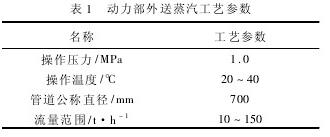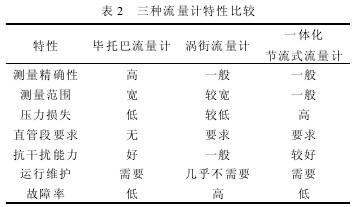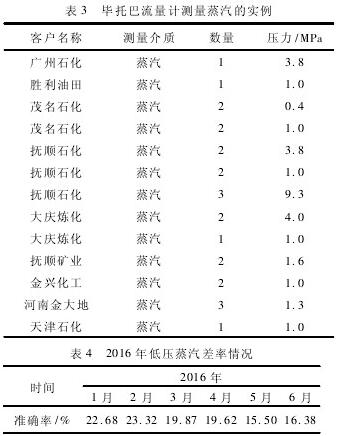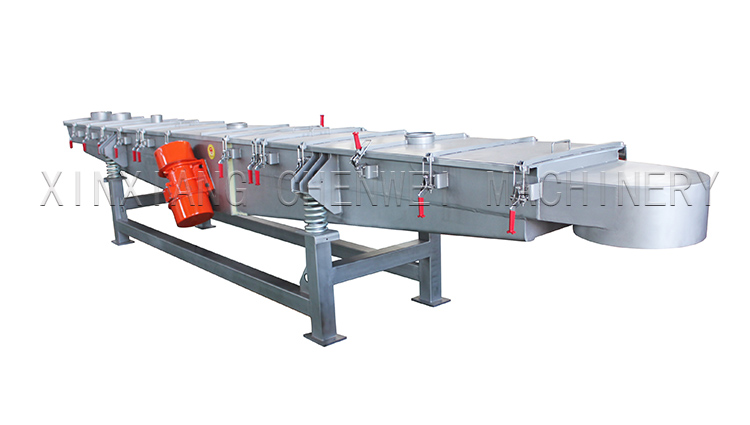0 profile
The low pressure steam sent by the Luoyang Petrochemical Power Department is an important output of the steam pipe network of our company. The accuracy of its measurement directly affects the compliance and economic calculation of each device, especially after the SMES3.0 energy metering module is put into operation. Accuracy of measurement puts forward new requirements. The power department sends the low-pressure steam pipeline to the large diameter of the DN700. The flow rate of the external steam due to production adjustment will cause the flow rate to fluctuate from 10 to 150 t/h. The original flow meter cannot meet the requirements of the enterprise's economic accounting. The use of major overhaul in 2015 to update to improve the measurement accuracy, therefore, to select a flowmeter to ensure large-caliber and wide-flow process conditions become a top priority.
1 Selection conditions
1.1 Characteristics of steam metering Steam is an important energy-carrying working medium and is widely used in petroleum, chemical, metallurgical, and urban heating industries. Because of the special nature of steam properties, it has long been a top priority in energy measurement. Steam metering has the following characteristics: 1 Steam quality correction and possible measurement of two-phase flow of steam, often changes in phase flow The steam, using the current flow meter to measure the flow, is not easy to accurately measure. 2 Due to production adjustments and changes in process conditions, the volatility of the steam volume is large, and the performance of the meter is difficult to adapt. 3 With the change of temperature and pressure, the physical properties of steam vary greatly, which makes it difficult to accurately measure. 4 Steam is a relatively expensive energy source for energy used in industrial production, which has a greater impact on the unit's economic accounting.
1.2 Process Parameters of External Steam in Power Department 
2 flow meter selection and analysis
According to the nature of the project conveying steam and process operating parameters, as well as the wide selection of flow meter models for steam metering, Pilot flowmeters, vortex street flowmeters and integrated flowmeters are the first to determine which flowmeters can be selected. The principle and characteristics of the three flowmeters are analyzed and compared.
2.1 Bittop flowmeter
Pittoba flowmeter is a differential pressure flowmeter that uses Pitot tube principle to extract the center fluid flow velocity (full pressure-static pressure=dynamic pressure) and convert it into fluid volume flow and mass flow. Pitot tube principle has long been widely used in the aerospace industry, such as: aircraft wind tunnel testing and testing, aircraft engine gas power test, speed of the aircraft flight speed bar, etc., technology is mature.
2.1.1 Composition and Working Principle
Pitot Barometer inserts the probe into the center of the pipe, the total pressure hole aligns the flow direction of the positive fluid, and the static pressure hole aligns the flow direction of the fluid. The difference between the total pressure and the static pressure is the measured differential pressure of the pipe center. The standard differential pressure at this point is then fitted by the calibration curve of the probe's wind tunnel, and the fluid flow is calculated based on the standard differential pressure. At the same time, the pressure transmitter is required to measure the fluid pressure, and the temperature of the fluid is measured with a thermistor thermometer. The standard differential pressure signal, pressure signal, and temperature signal are simultaneously introduced into the flow totalizer constituted by the single-chip microcomputer or directly connected to the DCS system. On the one hand, the flow equation of the probe is solved, and on the other hand, steam is subjected to pressure and temperature compensation to ensure measurement accuracy, and parameters such as differential pressure, pressure, temperature, instantaneous flow, cumulative flow, heat, and speed are digitally displayed.
2.1.2 Benefits of Pitobba Flowmeters
1 High accuracy. Steam measurement up to 0.5;
2 high reliability. Because the structure of the probe is very simple, the structure design is reasonable, the medium in the pressure guiding tube does not flow, and the debris is not easy to enter, so the measurement accuracy can be maintained for a long time;
3 wide measurement range. The flow rate can be accurately measured from 0.2 to 50000 t/h. For low flow rate, small flow, large diameter measurement is particularly good;
4 easy to install. Simply place an equivalent hole in the appropriate location on the pipe and insert the component probe into the center of the pipe to facilitate installation.
5 The pressure loss is small. The primary component sensor is made of Φ20mm~Φ55mm stainless steel. The cross-sectional area is very small, and there is almost no pressure loss in the medium pipeline. Compared with the throttling device such as the orifice plate, the energy saving effect is obvious; 6 On-site installation No straight pipe section is required.
2.1.3 Pitot Bar Flowmeter Disadvantages
1 The price is high, the cost performance is low; 2 the pressure pipe has no non-accumulated condensate setting and antifreeze setting.
2.2 vortex flowmeter
2.2.1 Composition and Working Principle
Vortex flowmeters are volumetric flowmeters. Vortex flowmeters measure the flow rate using the fluid oscillation principle. After the fluid passes through the vortex generating body in the pipeline, it generates a vortex proportional to the flow velocity, from which the fluid flow rate can be calculated. The relationship between flow rate and vortex frequency can be expressed by the following formula [1]: V=f/k
Where: f is the number of vortices; k is the meter factor; V is the volume of the flowing fluid.
2.2.2 The main advantages of vortex flowmeters for steam metering
1 The structure is simple and firm without moving parts, high reliability, and long-term operation is very reliable;
2 easy to install, maintenance is very convenient;
3 output is a pulse signal proportional to the flow rate, no zero drift, high accuracy;
4 less pressure loss, low operating costs, energy saving;
5 wide measurement range, up to 1:10 ratio;
6 Wide range of applications, steam, gas, liquid flow can be measured.
2.2.3 The disadvantages of vortex flowmeters for steam metering
1 Requirements The measured medium has a high Reynolds number lower limit, and the body flow rate should generally be greater than 4m/s. When the flow rate is too low, it will cause the measurement accuracy to decrease and even the small flow rate will not be measured. 2 It is sensitive to vibrations and operates in a strong vibration environment. , will affect the measurement accuracy; 3 on the cleanliness of the measured medium is higher, not suitable for measuring the frequency signal detector caused serious pollution of the dirty fluid.
2.3 Integrated Throttle Flowmeter
2.3.1 Integrated Throttle Flowmeter Structure and Operation
The integrated throttling flowmeter structure is shown in Figure 1. 
The integrated throttling flowmeter integrates the throttling device and the differential pressure transmitter, and the differential pressure transmitter outputs a 4~20mA differential pressure signal to measure various media (liquid, gas, and steam). Antifreeze isolators simplify the structure of the flowmeter and facilitate installation. The integrated throttling flow meter can use a variety of throttling devices, commonly used ISA1932 standard nozzle and standard orifice.
Intelligent flowmeter with integrated differential pressure transmitter and flow display device with communication function can realize wide-range ratio detection through HART protocol, flow measurement range can reach 6:1 to 10:1 or more width. The fluid filled with the pipe flows through the throttling device in the pipe, and the streamer will form a local contraction at the throttle, so that the flow velocity increases, the static pressure decreases, and a static pressure difference (or differential pressure) is generated before and after the throttle. The greater the flow velocity of the fluid, the greater the differential pressure generated before and after the throttle. Therefore, the flow rate can be measured by measuring the differential pressure [2].
2.3.2 Advantages of Integrated Throttle Flowmeters for Steam Metering
1 Measurement range width is approximately 10:1; 2 priority selected value ISO1932 nozzle, small pressure loss (with the same flow, with the same β value, 60% of the orifice plate), long test cycle (4 times the orifice plate) 3Pressure tube does not accumulate condensate water; 4Using patented technology—antifreeze separator, no need for heat, heat preservation and isolator, save energy; 5 medium applicability (especially suitable for steam flow measurement), dynamic performance Good, simple structure, low failure rate, easy installation and maintenance.
2.3.3 Disadvantages of Integrated Throttle Flowmeters for Steam Metering
1 The upstream and downstream straight sections should be round, with smooth inner walls, and their internal diameters should be the same as the nominal internal diameter of the flowmeter; 2 The integrated flowmeter must be installed vertically on the horizontal piping corresponding to its nominal diameter. The flowmeter should be equipped with a certain length of straight pipe section on the upstream side and downstream side of the measuring line.
2.4 Flowmeter Selection Analysis
According to the characteristics of the three types of flowmeters, they are compared from the aspects of measurement accuracy, measurement range, pressure loss, anti-jamming capability, and operation and maintenance, as shown in Table 2. 
Due to the large diameter of the measured medium (DN700) and the wide range of working flow (10 to 150 t/h), the vortex flowmeter and the integrated throttle flowmeter ensure poor measurement accuracy at low flow rates. Causes a certain amount of measurement error, and the measurement range of the Ventura flowmeter is wider, which can not only ensure accurate measurement of small flow, but also can meet the accurate measurement of large flow. At the same time, it is easier to install on large diameter. Referring to the successful experience of other enterprises Bittop flowmeters for measuring low pressure steam, as shown in Table 3, it is determined that the flow meter used for the measurement of low pressure steam is a three-compartment Pittoba steam flowmeter .
During the operation, attention should also be paid to: (1) Valves for pressure relief valves should be closed during pipeline purging or shooting in order to protect the flowmeter and ensure accurate measurement during normal production; 2 Because the flowmeter does not have a pressure tube to prevent condensation The site should be accompanied by heat.
3 Industrial use
In early November 2015, with the company's opportunity to stop work overhaul, we installed the Pitbull steam flow meter of the instrument. After commissioning, configuration, and other related work, the low-pressure steam supply to the steam system began in March. The data of this meter (FT414) prevail. Table 4 shows the steam accuracy rate of our company for the period from January to June 2016. 
It can be seen from Table 4 that after the steam meter (FT414) was put into use, with the increase of the accuracy of steam metering, the low pressure steam pipe network rate of Luoyang Petrochemical Company decreased effectively, and the meter is currently operating well.
4 Conclusion
Through the selection and analysis of the steam using the flowmeter, it can be determined that the Pitobba flowmeter has obvious advantages in the measurement of large-diameter and wide-flow steam, and provides a better measurement plan for the steam transfer measurement, but in the specific measurement In the above, it is necessary to pay attention to the fact that the flowmeter does not have a pressure pipe to prevent the setting of condensate, and to do inspection work when the equipment is accompanied by heat and season change, so as to ensure the accuracy and reliability of steam measurement.
Description
Vibrating Conveyors consist of vibration motor,trough,vibration damper,support base and other accessories.it offers a simple and efficient means to meter and convey dry bulk material.Two highly efficient, externally mounted vibrators provide quiet, linear motion and make bulk material moving forward smoothly. There are no dead angle, bearings or seals which can degrade material, leak or require maintenance.These open or enclosed units will handle nearly any material, regardless of size and bulk density in a reliable and economical manner.
The vibrating conveyor can be designed for screening,drying or cooling usage ,by adding the electricity weighing module,the machine can have function of precise feeding.
Feature
* Simple structure and easy for maintenance
* Long service life and no vulnerable part
* Low noise and large capacity
* Low power consumption
* Up to 8 meters long
Application
The machine is available in the industries such as metallurgy, mining, pharmacy, food, chemical, metal powder and nonmetal material etc.
Our machines have an automatic 12 months guarantee against faulty material and workmanship valid from the date of dispatch in China or date of arrival at foreign border.
If any problem of the machine under instruction within one year,we are responsible for replacement incuding delivery fee and maintenance.
Lifelong service is offered with cost charge after one year.

Vibrating Feeder,Vibrating Crusher Feeder,Grizzly Vibrating Feeder,Chute Vibrating Feeder
XINXIANG CHENWEI MACHINERY CO.,LTD , https://www.cwsieve.com